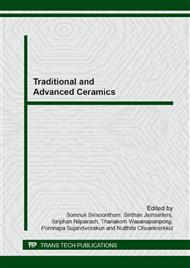p.3
p.8
p.14
p.21
p.26
p.31
p.37
p.41
Using Lime Mud Waste from Pulp Mill as an Additive in Brick Clay
Abstract:
Lime mud from a pulp mill was used as an additive in brick clay from the southern part of Thailand. It was mixed with the clay from Cha-Aud district, Nakorn Sithammarat province. The chemical composition of lime mud and the clay was characterised by X-ray fluorescence (XRF), and the mineralogical composition was measured by X-ray diffraction (XRD). The particle size distribution was also measured. The main composition of lime mud is CaO, and Cha-Aud clay consists of SiO2 and Al2O3 as major oxides. The lime mud contains calcite as a major phase when Cha-Aud clay is constituted by quartz, kaolinite, illite and goethite. Particle size distribution of lime mud is in the range of 1-50 μm. After the lime mud was neutralized using hydrochloric acid, it was mixed with Cha-Aud clay at 10 wt%. Samples with and without lime mud were sintered at 700, 800, 900 and 1000°C for 1 hour. The results showed that lime mud can be used as an additive in brick clay. Both types of samples were similar in terms of physical properties when their linear firing shrinkage, water absorption and flexural strength were in the same range.
Info:
Periodical:
Pages:
3-7
Citation:
Online since:
April 2014
Authors:
Keywords:
Price:
Сopyright:
© 2014 Trans Tech Publications Ltd. All Rights Reserved
Share:
Citation:


